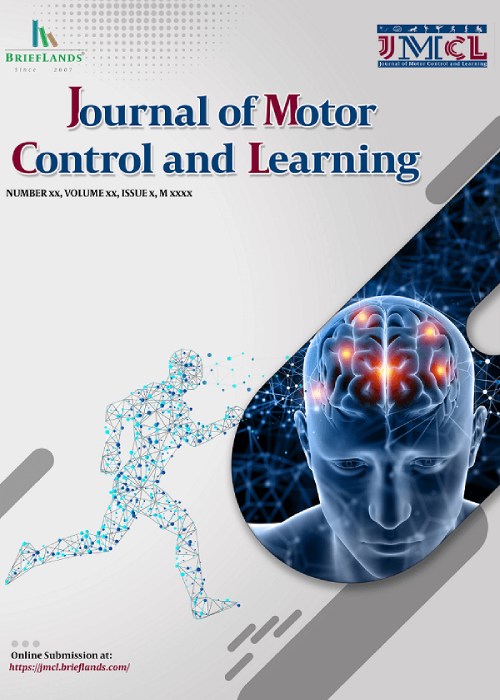فهرست مطالب
Journal of Motor Control and Learning
Volume:2 Issue: 4, Autumn 2020
- تاریخ انتشار: 1399/08/19
- تعداد عناوین: 6
-
Pages 4-10Background
Mental fatigue is a psychobiological state caused by prolonged periods of demanding cognitive activity.
ObjectiveThis study aimed to investigate the effect of mental fatigue on three-point shots in skilled basketball players.
MethodsThis study was semi-experimental. For this purpose, 18 male experienced basketball players were selected by convenience sampling and randomly divided into experimental and control groups (control: n=9, experimental: n=9). Participants in the experimental group experienced mental fatigue using strop software and math tests, but the control group did not perform any specific cognitive tasks during this time. Visual Analog Scale and three-point shots were used as a pretest and posttest. For data analyzing, the SPSS 25 was applied, and the significance level was considered at (p<0/05).
ResultsThe results of the study illustrated that spatial working memory played a predictive role in selected attention (same color and font, and different color and font) and performance accuracy; Moreover, mathematical working memory played a predictive role in selected attention (same color and font, and different color and font). However, it did not have a predictive role in performance accuracy.
ConclusionThe result of this study supports the theory that mental fatigue had impact on athletic performance. It is suggested that basketball players and coaches consider mental fatigue in sports performance.
Keywords: Exercise, Basketball, Three-Point Shoot, Mental Fatigue -
Pages 11-20Background
One of the most important factors affecting the optimal implementation of motor skills and reaching the peak of performance in sports and competitive environments is the use of psychological skills.
ObjectiveThe aim of the present study was to compare the psychological skills of Iranian elite swimmers based on competitive experience, gender, age and swimming distance.
MethodsFor this purpose, 93 elite swimmers were selected as available subjects. The Amst 3 questionnaire was used to measure the psychological skills of swimmers and then the findings were analyzed using SPSS software.
ResultsThe results of independent t-test and U-Man Whitney showed that there was no significant statistical difference between the psychological skills of Iranian elite swimmers based on competitive experience, age, gender and distance of swimming.
ConclusionIt seems that Iranian elite swimmers have learned psychological skills through natural learning, and this has made the level of psychological skills of Iranian elite swimmers about the same. Therefore, the need to use psychological interventions is important for elite Iranian swimmers.
Keywords: Psychological Skills, Elite Swimmers, Individual Sport -
Pages 21-30Background
Serial Reaction Time (SRT) is a simple task specifically designed to examine reaction time and learn implicit sequences.
ObjectiveThe aim of the present study was to evaluate the effect of gender (male and female) and type of stimulus (orderly and disorderly) on the serial reaction time.
MethodsThe sample included 30 students of physical education (15 males & 15 females). All subjects were right-handed and none had a history practice serial reaction time task. To measure the reaction time was used a serial-reaction time test (SRTT), that was included 8 blocks and stimulants were presented on the screen for blue, yellow, red and green and participants responded to stimuli with non-dominant hand. To investigate the effects of gender and type of stimuli was used repeated measures ANOVA test.
ResultsThe results showed that gender has not significant effect on response time, but has significant effects of the stimulus presentation on reaction times and reaction time higher in stimuli disorderly.
ConclusionThe findings suggest that exercise can be effective on reaction time and eliminate gender differences in reaction time. Also, implicit learning during the implementation serial reaction time of orderly stimulus is affected in the reaction time.
Keywords: Serial Reaction Time, Sex Difference, Orderly Stimulus, Disorderly Stimulus -
Pages 31-41Objective
The aim of this study was to determine the differences between different methods of contextual interference (High and Low) on accuracy.
MethodsThe subjects were 51 people from Shiraz Mental Health Park Rehabilitation Center who were purposefully selected and after the pre-test, they were randomly divided into three groups. The High and Low interference groups performed 180 Frisbee attempts (backhand, forehand, and hammer) and the control group played a team game at the same time as the intervention groups. Then, acquisition, retention and immediate transfer tests were taken. Accuracy was measured using a researcher-made test.
ResultsThe results of repeated measures test showed no significant difference in the phase of acquisition and there was a significant difference between the groups in the phases of transfer (P = 0.011) and retention (P = 0.026).
ConclusionIt seems that the results of this study can be effective in reducing researcherschr('39') concerns in simultaneous training of several motor skills by emphasizing the movement pattern and achieving the goal of movement (accuracy). Findings indicate that the use of contextual interference methods, at high levels, leads to time savings and stabilizes the pattern of movement in the learning phases.
Keywords: Exercise, Contextual Interference, Accuracy, Performance -
Pages 41-45Objective
The purpose of this study was to investigate the effect of learning type on balance.
MethodsFor this purpose, 80 female students aged 9-12 years who were selected by random cluster sampling and after Flamingo test, they were divided into two groups randomly: explicit learning and implicit learning. The subjects were required to maintain balance on the Stabilometer. The acquisition stage included 24 attempts 60 seconds. Explicit learning groups received feedback while on the device, but the implicit learning group was required to perform a secondary cognitive task in addition to maintaining a balance without receiving feedback.
ResultsAnalysis of covariance with a significant level of р≤ 0.05 showed that there was no significant difference between explicit and implicit learning in static balance.
ConclusionThe results indicate that the subjects of both groups had improvement in their post-test balance records compared to the pre-test. Therefore, probably the static balance with regard to its subcortical mechanism cannot be influenced by the type of learning.
Keywords: Explicit Learning, Implicit Learning, Static Balance


